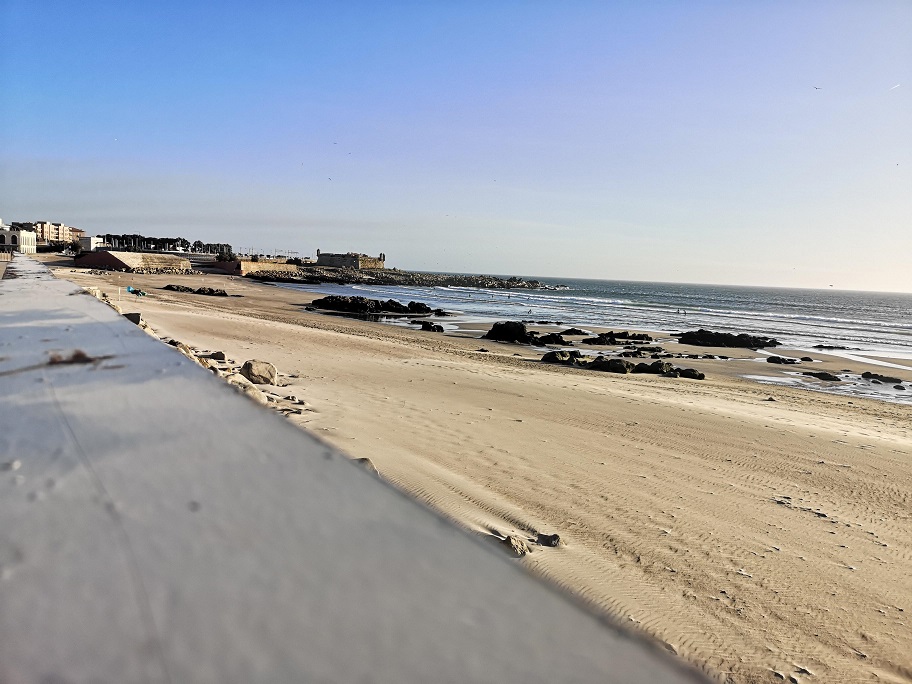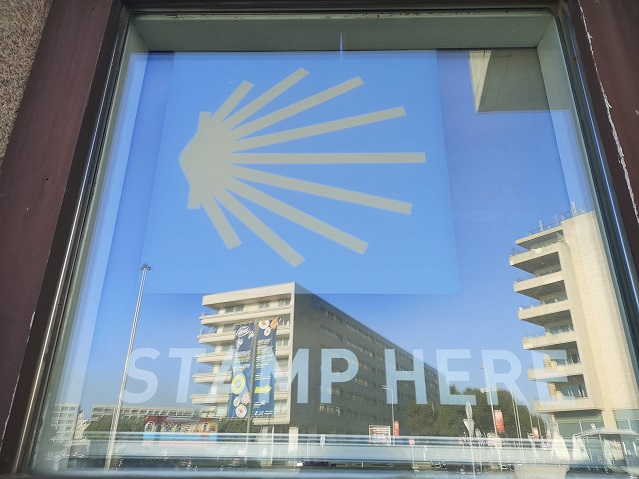Porto to Matosinhos to Vila do Conde – days 1 and 2 of my Camino Portuguese Coastal and Littoral routes (280 kms in total) * September 19th and 20th 2019 were the Littoral, that is, they followed the coast with all its ins and outs.

This is a walk from Porto in Portugal to Santiago de Compostella in Spain. There are 3 routes – the quickest is inland, and the other 2 travel along the coast, some more literally than others. It is the second most popular Way – the Camino Frances from Saint Jean Pied de Port in France to Santiago being the most famous.

I stayed at the Albergue Peregrinos do Porto which was great. There was a friendly welcome from the group at the desk and I was able to buy my Credential (the first of the new version, I was told) which is the folded paper which I carried with me everywhere thereafter, and which had to be stamped twice a day (by hostels, cathedrals or cafes etc) if I was to be able to get a Compostella, which is the certificate you can buy in Santiago de Compostella to prove that you have completed the camino.
There is a beautiful garden which was ideal for me to do peaceful tai chi in and for sitting with a drink in the evenings. The only drawback was that the showers were also outside. Ordinarily this would not bother me at all, but mosquitos adore standing water and I was bitten to within an inch of my life. Not everyone is as delicious as me, and I had taken steps to put them off, but the bites lasted for well over a week and left scars. The bunk bed was 12€ per night/person. (10€ for the Albergue and 2€ for the touristic municipal taxes).

There’s lots to see on your way out of Porto: first along the Douro River, under the bridges, past beaches, restaurants and cafes (especially the Foz district which is smart), the lighthouse (Capel Farol Sao Miguel-do-Anjo), two forts, a helicopter pad, gardens and statues.

If you wanted to get to Labruge, the end of stage one (24.5kms from Porto), but take a shorter walk, you can take the Line 1 tram from Ribeira, with your rucksack, as far as Foz do Douro (remember to sit on the left so you can see the view!). Then you could have a coffee by Jardim do Passeio Alegre (Cheerful Walk Garden, according to Google Translate!) with its fountain and cool shade, before starting to walk. This will save you 6kms (1 hour and 10 minutes at the average walking speed).




The Fort of St Francis (Francisco) Xavier was designed by Miguel l’Ecole (1661). Occupied by Absolutists in 1832, it was badly damaged in a battle with the Liberals and abandoned. Later it was used as the headquarters of the Oporto Naval Brigade’s 1st Company, and is now the Northern Commandos Association


I had a lovely swim. All along here the waves tend to be strong and I noticed that most locals do not take the plunge.


In Matosinhos I stayed at the Hostel Matosinhos Suites, a funny modern block in the heart of this area, a suburb of Porto. The room was small with 6 bunks packed into it. It had a table and 2 chairs (for 6 people), a kettle and mini fridge (but not enough sockets) and it got very hot with us all in. There was a small balcony where we managed to negotiate hanging up the washing by stringing a small rope and sharing pegs – just! It was clean and there were curtains across each bunk. Cost: 22 euros through booking.com.
There are loads of places to eat, including underneath the Suites. Matosinhos is best known as the place where Porto inhabitants leave the city and come to sit in the seaside restaurants to eat the famous shellfish.








There was a diverse range of flowers, mostly growing close to the ground on account of the wind, many of them also fleshy so they can survive without rain.





That night’s rest was in Albergue Santa Clara Albergue de Peregrinos Municipal (which can be found on Facebook). It has a large dining area which was very busy, and a small kitchen. Beware of leaving food out – someone went off with my hard boiled eggs which were in a cup cooling for breakfast 😦


The hostel overlooks the Igreja Sao Joao Baptista (Church of St John the Baptist) and a lively marketplace. There is a cafe just around the corner where you can sit outside with your beer (very good value), and it is in the centre of town for all other amenities.


*There is a variation to the Portuguese Camino da Costa and Litoral (this word has 1 or 2 t’s depending on the language), which is reputedly very, very beautiful, called the Espiritual (Spiritual). It starts in Pontevedra (where the Inland and Coastal routes converge), and ends in Padron. More information here
Portuguese Camino next days 3 and 4 Vila do Conde to Viana do Castelo

I’m reluctant to take the tram to Matasinhos. I notice a lot of pilgrims do it (correct me if I’m wrong). Did you meet many who preferred to walk direct to Vila do Conde. Thanks for the posts btw.
LikeLike
Hi, thanks for commenting. No, I didn’t meet anyone who did that, but it’s a long first day and my suggestion was to take the tram to the end of the line, Foz do Douro, not to Matosinhos. Some will be stronger and more experienced hikers than others so I thought it might be an option to go to the outskirts of the city and then walk. Even according to Google maps that’s 5.5 hours and by the coast it would be longer. Getting blisters or an injury on the first day would be a sorry thing if by any chance they weren’t yet hardy enough. What do you think?
LikeLiked by 1 person
I agree. It is a long day. I was debating whether to stay in Matasinhos the evening before and walk to Vila do Conde.
LikeLike
It’s an interesting place to stay, more urban than rural, but plenty of great places to eat and choice of accommodation. Breaks that first day into 2 easy chunks!
LikeLike